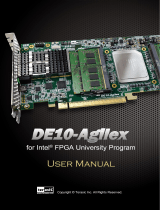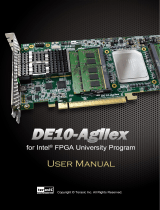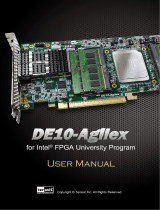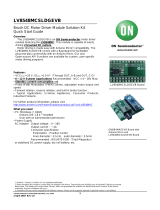Page is loading ...

DE10-Lite
User Manual
1
www.terasic.com
January 24, 2017
CONTENTS
Chapter 1 Introduction ..................................................................................................... 3
1. 1 Package Contents ............................................................................................................................ 3
1. 2 DE10-Lite System CD .................................................................................................................... 4
1. 3 Layout and Components ................................................................................................................. 4
1. 4 Block Diagram of the Board ........................................................................................................... 6
1. 5 Getting Help .................................................................................................................................... 7
Chapter 2 Control Panel ................................................................................................... 8
2. 1 Control Panel Setup ........................................................................................................................ 8
2. 2 Controlling the LEDs, 7-segment Displays................................................................................... 10
2. 3 Switches and Push-buttons ............................................................................................................ 12
2. 4 SDRAM Controller and Programmer ........................................................................................... 12
2. 5 Accelerometer ............................................................................................................................... 14
2. 6 VGA .............................................................................................................................................. 15
2. 7 Overall Structure of the DE10-Lite Control Panel ........................................................................ 16
Chapter 3 Using the Starter Kit ................................................................................... 17
3. 1 Configuration of MAX 10 FPGA on DE10-Lite ........................................................................... 17
3. 2 Clock Circuitry .............................................................................................................................. 24
3. 3 Using the Push-buttons, Switches and LEDs ................................................................................ 25
3. 4 Using the 7-segment Displays ....................................................................................................... 28
3. 5 Using 2x20 GPIO Expansion Headers .......................................................................................... 30
3. 6 Using Arduino Uno R3 Expansion Header ................................................................................... 32
3. 7 A/D Converter and Analog Input .................................................................................................. 34
3. 8 Using VGA ................................................................................................................................... 35
3. 9 Using SDRAM .............................................................................................................................. 37
3. 10 Using Accelerometer Sensor ......................................................................................................... 39
Chapter 4 DE10-Lite System Builder ............................................................................ 41
4. 1 Introduction ................................................................................................................................... 41
4. 2 General Design Flow .................................................................................................................... 42

DE10-Lite
User Manual
2
www.terasic.com
January 24, 2017
4. 3 Using DE10-Lite System Builder ................................................................................................. 43
Chapter 5 Examples of Advanced Demonstrations .................................................... 48
5. 1 DE10-Lite Factory Configuration ................................................................................................. 48
5. 2 SDRAM Test in Nios II ................................................................................................................. 50
5. 3 SDRAM Test in Verilog ................................................................................................................ 53
5. 4 VGA Pattern .................................................................................................................................. 55
5. 5 G-Sensor ........................................................................................................................................ 57
5. 6 ADC Measurement ....................................................................................................................... 59
Chapter 6 Programming the Configuration Flash Memory ..................................... 61
6. 1 Internal Configuration ................................................................................................................... 62
6. 2 Using Dual Compressed Images ................................................................................................... 64

DE10-Lite
User Manual
3
www.terasic.com
January 24, 2017
Chapter 1
Introduction
The DE10-Lite presents a robust hardware design platform built around the Altera MAX 10 FPGA.
The MAX 10 FPGA is well equipped to provide cost effective, single-chip solutions in control
plane or data path applications and industry-leading programmable logic for ultimate design
flexibility. With MAX 10 FPGA, you can get lower power consumption / cost and higher
performance. When you need high-volume applications, including protocol bridging, motor control
drive, analog to digital conversion, image processing, and handheld devices, the MAX 10 Lite
FPGA is your best choice.
The DE10-Lite development board includes hardware such as on-board USB Blaster, 3-axis
accelerometer, video capabilities and much more. By leveraging all of these capabilities, the
DE10-Lite is the perfect solution for showcasing, evaluating, and prototyping the true potential of
the Altera MAX 10 FPGA.
The DE10-Lite contains all components needed to use the board in conjunction with a computer
that runs the Microsoft Windows XP or later.
1
1.
.
1
1
P
Pa
ac
ck
ka
ag
ge
e
C
Co
on
nt
te
en
nt
ts
s
Figure 1-1 shows a photograph of the DE10-Lite package.
Figure 1-1 The DE10-Lite package contents

DE10-Lite
User Manual
4
www.terasic.com
January 24, 2017
The DE10-Lite package includes:
The DE10-Lite board
Type A Male to Type B Male USB Cable
1
1.
.
2
2
D
DE
E1
10
0-
-L
Li
it
te
e
S
Sy
ys
st
te
em
m
C
CD
D
The DE10-Lite System CD contains the documentation and supporting materials, including the
User Manual, Control Panel, System Builder, reference designs and device datasheets.
User can download this System CD from the web (http://DE10-Lite.terasic.com/cd).
1
1.
.
3
3
L
La
ay
yo
ou
ut
t
a
an
nd
d
C
Co
om
mp
po
on
ne
en
nt
ts
s
This section presents the features and design characteristics of the board.
A photograph of the board is shown in Figure 1-2 and Figure 1-3. It depicts the layout of the board
and indicates the location of the connectors and key components.
Figure 1-2 Development Board (top view)

DE10-Lite
User Manual
5
www.terasic.com
January 24, 2017
Figure 1-3 Development Board (bottom view)
This board has many features that allow users to implement a wide range of designed circuits, from
simple circuits to various multimedia projects.
The following hardware are provided on the board:
F
FP
PG
GA
A
D
De
ev
vi
ic
ce
e
MAX 10 10M50DAF484C7G Device
Integrated dual ADCs, each ADC supports 1 dedicated analog input and 8 dual function pins
50K programmable logic elements
1,638 Kbits M9K Memory
5,888 Kbits user flash memory
144 18 × 18 Multiplier
4 PLLs
P
Pr
ro
og
gr
ra
am
mm
mi
in
ng
g
a
an
nd
d
C
Co
on
nf
fi
ig
gu
ur
ra
at
ti
io
on
n
On-Board USB Blaster (Normal type B USB connector)
M
Me
em
mo
or
ry
y
D
De
ev
vi
ic
ce
e
64MB SDRAM, x16 bits data bus

DE10-Lite
User Manual
6
www.terasic.com
January 24, 2017
C
Co
on
nn
ne
ec
ct
to
or
rs
s
2x20 GPIO Header
Arduino Uno R3 Connector, including six ADC channels.
D
Di
is
sp
pl
la
ay
y
4-bit resistor-network DAC for VGA (With 15-pin high-density D-sub connector)
S
Sw
wi
it
tc
ch
he
es
s,
,
B
Bu
ut
tt
to
on
ns
s
a
an
nd
d
L
LE
ED
Ds
s
10 LEDs
10 Slide Switches
2 Push Buttons with Debounced.
Six 7-Segments
P
Po
ow
we
er
r
5V DC input from USB or external power connector.
1
1.
.
4
4
B
Bl
lo
oc
ck
k
D
Di
ia
ag
gr
ra
am
m
o
of
f
t
th
he
e
B
Bo
oa
ar
rd
d
Figure 1-4 gives the block diagram of the board. To provide maximum flexibility for the user, all
connections are made through the MAX 10 FPGA device. Thus, the user can configure the FPGA to
implement any system design.
Figure 1-4 Board Block Diagram

DE10-Lite
User Manual
7
www.terasic.com
January 24, 2017
1
1.
.
5
5
G
Ge
et
tt
ti
in
ng
g
H
He
el
lp
p
Here are the addresses where you can get help if you encounter any problem:
Terasic Inc.
9F., No.176, Sec.2, Gongdao 5th Rd, East Dist, Hsinchu City, 30070. Taiwan
Email: [email protected]
Tel.: +886-3-5750-880
Web: http://DE10-Lite.terasic.com

DE10-Lite
User Manual
8
www.terasic.com
January 24, 2017
Chapter 2
Control Panel
The DE10-Lite board comes with a Control Panel program that allows users to access various
components on the board from a host computer. The host computer communicates with the board
through a USB connection. The program can be used to verify the functionality of components on
the board or be used as a debug tool while developing any RTL code.
This chapter first presents some basic functions of the Control Panel, then describes its structure in
the block diagram form, and finally describes its capabilities.
2
2.
.
1
1
C
Co
on
nt
tr
ro
ol
l
P
Pa
an
ne
el
l
S
Se
et
tu
up
p
The Control Panel Software Utility is located in the directory “Tools/ControlPanel” in the
DE10-Lite System CD. It's free of installation, just copy the whole folder to your host computer
and launch the control panel by executing the “DE10_Lite_ControlPanel.exe”.
Specific control circuits should be downloaded to your FPGA board before the control panel can
request it to perform required tasks. The program will call Quartus II tools to download the control
circuit to the FPGA board through the USB-Blaster[USB-0] connection.
To activate the Control Panel, perform the following steps:
1. Make sure Quartus II 16.0 or a later version is installed successfully on your PC.
2. Connect the USB cable provided to the USB Blaster port.
3. Start the executable DE10_Lite_ControlPanel.exe on the host computer. The Control Panel user
interface shown in Figure 2-1 will appear.
4. The DE10_Lite_ControlPanel.sof bit stream is loaded automatically as soon as the
DE10_Lite_ControlPanel.exe is launched.
5. In case of a disconnection, click on CONNECT where the .sof will be re-loaded onto the board.
Please note that the Control Panel will occupy the USB port until you close that port; you cannot use
Quartus II to download a configuration file into the FPGA until the USB port is closed.

DE10-Lite
User Manual
9
www.terasic.com
January 24, 2017
6. The Control Panel is now ready to use; experience it by setting the ON/OFF status for some
LEDs and observing the result on the DE10-Lite board.
Figure 2-1 The DE10-Lite Control Panel
The concept of the DE10-Lite Control Panel is illustrated in Figure 2-2. The “Control Circuit” that
performs the control functions is implemented in the FPGA board. It communicates with the
Control Panel window, which is active on the host computer, via the USB Blaster link. The
graphical interface is used to send commands to the control circuit. It handles all the requests and
performs data transfers between the computer and the DE10-Lite board.

DE10-Lite
User Manual
10
www.terasic.com
January 24, 2017
Figure 2-2 The DE10-Lite Control Panel concept
The DE10-Lite Control Panel can be used to light up LEDs, change the values displayed on the
7-segment, monitor buttons/switches status, read/write the SDRAM Memory, output VGA color
pattern to VGA monitor. The feature of reading/writing a word or an entire file from/to the Memory
allows the user to develop multimedia applications without worrying about how to build a Memory
Programmer.
2
2.
.
2
2
C
Co
on
nt
tr
ro
ol
ll
li
in
ng
g
t
th
he
e
L
LE
ED
Ds
s,
,
7
7-
-s
se
eg
gm
me
en
nt
t
D
Di
is
sp
pl
la
ay
ys
s
A simple function the Control Panel is capable of is the modification of settings for the 7-segement
LED displays.
Choosing the LED tab leads you to the window in Figure 2-3. Here, you can directly turn the LEDs
on or off individually or by clicking “Light All” or “Unlight All”.

DE10-Lite
User Manual
11
www.terasic.com
January 24, 2017
Figure 2-3 Controlling LEDs
Choosing the 7-SEG tab leads you to the window shown in Figure 2-4. From the window, directly
use the left-right arrows to control the 7-SEG patterns on the DE10-Lite board which are updated
immediately. Note that the dots of the 7-SEGs are not enabled on the DE10-Lite board.
Figure 2-4 Controlling 7-SEG display

DE10-Lite
User Manual
12
www.terasic.com
January 24, 2017
The ability to set arbitrary values into simple display devices is not needed in typical design
activities. However, it gives users a simple mechanism for verifying that these devices are
functioning correctly in case a malfunction is suspected. Thus, it can be used for troubleshooting
purposes.
2
2.
.
3
3
S
Sw
wi
it
tc
ch
he
es
s
a
an
nd
d
P
Pu
us
sh
h-
-b
bu
ut
tt
to
on
ns
s
Choosing the Switches tab leads you to the window in Figure 2-5. The function is designed to
monitor the status of slide switches and push buttons in real time and show the status in a graphical
user interface. It can be used to verify the functionality of the slide switches and push-buttons.
Figure 2-5 Monitoring switches and buttons
The ability to check the status of push-button and slide switch is not needed in typical design
activities. However, it provides users a simple mechanism to verify if the buttons and switches are
functioning correctly. Thus, it can be used for troubleshooting purposes.
2
2.
.
4
4
S
SD
DR
RA
AM
M
C
Co
on
nt
tr
ro
ol
ll
le
er
r
a
an
nd
d
P
Pr
ro
og
gr
ra
am
mm
me
er
r
The Control Panel can be used to write/read data to/from the SDRAM chips on the DE10-Lite board.
As shown below, we will describe how the SDRAM may be accessed; Click on the Memory tab and
select “SDRAM” to reach the window in Figure 2-6.

DE10-Lite
User Manual
13
www.terasic.com
January 24, 2017
Figure 2-6 Accessing the SDRAM
A 8-bit word can be written into the SDRAM by entering the address of the desired location,
specifying the data to be written, and pressing the Write button. Contents of the location can be read
by pressing the Read button. Figure 2-6 depicts the result of writing the hexadecimal value AB
into hexadecimal offset address C00, followed by reading the same location.
The Sequential Write function of the Control Panel is used to write the contents of a file into the
SDRAM as follows:
1. Specify the hexadecimal starting address in the Address box.
2. Specify the hexadecimal number of bytes to be written in the Length box. If the entire file is
to be loaded, then a checkmark may be placed in the File Length box instead of giving the
number of bytes.
3. To initiate the writing process, click on the Write a File to Memory button.
4. When the Control Panel responds with the standard Windows dialog box asking for the
source file, specify the desired file location in the usual manner.
The Control Panel also supports loading files with a .hex extension. Files with a .hex extension are
ASCII text files that specify memory values using ASCII characters to represent hexadecimal
values. For example, a file containing the line
0123456789ABCDEF

DE10-Lite
User Manual
14
www.terasic.com
January 24, 2017
defines eight 8-bit values: 01, 23, 45, 67, 89, AB, CD, EF. These values will be loaded
consecutively into the memory.
The Sequential Read function is used to read the contents of the SDRAM and fill them into a file as
follows:
1. Specify the hexadecimal starting address in the Address box.
2. Specify the hexadecimal number of bytes to be copied into the file in the Length box. If the
entire contents of the SDRAM are to be copied (which involves all 64 Mbytes), then place a
checkmark in the Entire Memory box.
3. Press Load Memory Content to a File button.
4. When the Control Panel responds with the standard Windows dialog box asking for the
destination file, specify the desired file in the usual manner.
2
2.
.
5
5
A
Ac
cc
ce
el
le
er
ro
om
me
et
te
er
r
The G-Sensor in the accelerometer utilizes a spirit level to function. The user can rotate the
DE10-LIte board different directions, up or down, left or right. The bubble will travel quickly travel
in respect to the user’s movements. Meanwhile, the control panel will show the accelerated data in
x-axis, y-axis and z-axis as shown in Figure 2-7. Note that the resolution measurement of 3-axises
accelerometer is set to +/- 2g.
Figure 2-7 Level by G-Sensor

DE10-Lite
User Manual
15
www.terasic.com
January 24, 2017
2
2.
.
6
6
V
VG
GA
A
DE10-Lite Control Panel provides VGA pattern function that allows users to output color pattern to
LCD/CRT monitor using the DE10-Lite board. Follow the steps below to generate the VGA pattern
function:
Choosing the VGA tab leads you to the window in Figure 2-8.
Plug a D-sub cable to the VGA connector of the DE10-Lite board and LCD /CRT monitor.
The LCD/CRT monitor will display the same color pattern on the control panel window.
Click the drop down menu shown in Figure 2-8 where you can output the selected pattern
individually.
Figure 2-8 Controlling VGA display under Control Panel

DE10-Lite
User Manual
16
www.terasic.com
January 24, 2017
2
2.
.
7
7
O
Ov
ve
er
ra
al
ll
l
S
St
tr
ru
uc
ct
tu
ur
re
e
o
of
f
t
th
he
e
D
DE
E1
10
0-
-L
Li
it
te
e
C
Co
on
nt
tr
ro
ol
l
P
Pa
an
ne
el
l
The DE10-Lite Control Panel is based on a Nios II Qsys system instantiated in the MAX 10 FPGA
with software running on the on-chip memory. The software was implemented in coding Language
C; and the hardware was implemented in Verilog HDL code with Qsys builder. The source code is
not available on the DE10-Lite System CD.
To run the Control Panel, users should follow the configuration setting according to Section 3.1.
Figure 2-9 depicts the structure of the Control Panel. Each input/output device is controlled by the
Nios II Processor instantiated in the FPGA chip. The communication with the PC is done via the
USB Blaster link. The Nios II interprets the commands sent from the PC and performs the
corresponding actions.
Figure 2-9 The block diagram of the DE10-Lite control panel

DE10-Lite
User Manual
17
www.terasic.com
January 24, 2017
Chapter 3
Using the Starter Kit
This chapter provides instructions to use the board and describes the peripherals.
3
3.
.
1
1
C
Co
on
nf
fi
ig
gu
ur
ra
at
ti
io
on
n
o
of
f
M
MA
AX
X
1
10
0
F
FP
PG
GA
A
o
on
n
D
DE
E1
10
0-
-L
Li
it
te
e
There are two types of configuration method supported by DE10-Lite:
1. JTAG configuration: configuration using JTAG ports.
JTAG configuration scheme allows you to directly configure the device core through JTAG pins -
TDI, TDO, TMS, and TCK pins. The Quartus II software automatically generates .sof files that are
used for JTAG configuration with a download cable in the Quartus II software program.
2. Internal configuration: configuration using internal flash.
Before internal configuration, you need to program the configuration data into the configuration
flash memory (CFM) which provides non-volatile storage for the bit stream. The information is
retained within CFM even if the DE10-Lite board is turned off. When the board is powered on, the
configuration data in the CFM is automatically loaded into the MAX 10 FPGA.
JTAG Chain on DE10-Lite Board
The FPGA device can be configured through JTAG interface on DE10-Lite board, but the JTAG
chain must form a closed loop, which allows Quartus II programmer to the detect FPGA device.
Figure 3-1 illustrates the JTAG chain on DE10-Lite board
Figure 3-1 The JTAG configuration scheme

DE10-Lite
User Manual
18
www.terasic.com
January 24, 2017
Configure the FPGA in JTAG Mode
The following shows how the FPGA is programmed in JTAG mode step by step.
1. Open the Quartus II programmer, please Choose Tools > Programmer. The Programmer
window opens. See Figure 3-2.
Figure 3-2 Programmer Window
2. Click “Hardware Setup”, as circled in Figure 3-2.
3. If it is not already turned on, turn on the USB-Blaster [USB-0] option under currently selected
hardware and click “Close” to close the window. See Figure 3-3.
/














